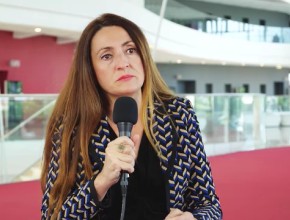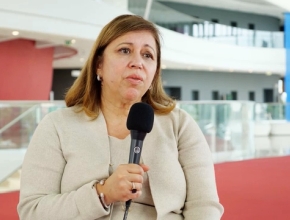Mariusz Korkosz: Today we have the pleasure to have here Professor Filip van Den Bosch from Belgium, an expert in the field of spondyloarthritis. In the last 10 years, we witnessed a significant progress in the field of spondyloarthritis, including both basic research and clinical research. We can use now the new classification criteria for axial and peripheral spondyloarthritis. I think that imaging is a key issue in axial spondyloarthritis. What is the role of magnetic resonance imaging (MRI) in nonradiographic axial spondyloarthritis, previously called early?
Filip Van den Bosch: I think, as you already mentioned, MRI plays a crucial role in the detection of early forms of spondyloarthritis. It used to be with ankylosing spondyloarthritis that we had to wait more or less 5 to 10 years before we could actually make a radiographic diagnosis. MRI has allowed us to do that much earlier by showing signs of inflammation, and I think that is where its main role is. I think it should be an addition to our clinical exam, to our history-taking of the patient; that should always be the first thing. It should be the typical signs and symptoms of someone with actual disease in the setting of spondyloarthritis. Then the MRI is used to confirm that there is indeed significant inflammation.
The danger, if we can talk about that also, of MRI is that to some extent unexperienced readers or unexperienced radiologists might detect low levels of light dots on the MRI, which may not be significant enough to consider this as real bone marrow edema in the setting of axial spondyloarthritis. But I think there is still research agenda to further define this and refine the way we use MRI.
Mariusz Korkosz: Are there any pitfalls for unexperienced radiologists, as you said?
Filip Van den Bosch: I think the pitfall is indeed that physicians, whether it is rheumatologists or if they refer their patients to radiologists, tend to put the radiograph or the MRI in the first place. If you do that, you will find in some patients, especially when you get older — but we have preliminary data which we will present at the European League Against Rheumatism (EULAR) [Congress] to state that already in young people you can find mild forms of bone marrow edema, even if they do not have any complaints. I think the pitfall is really that MRI should be a tool to be used in the setting of a clinical diagnosis and it should not be the diagnosis itself. We should never allow radiologists to make a diagnosis of nonradiographic axial spondyloarthritis. That should be reserved for the rheumatologist, who knows the full spectrum and the full picture.
Mariusz Korkosz: Also, a tremendous progress has been seen in treatment of spondyloarthritis. It seems that tumor necrosis factor (TNF) inhibitors are now the number one biologics in axial spondyloarthritis. But imagine a scenario in which the patient does not respond to TNF inhibitors. Do we have other strategies for that?
Filip Van den Bosch: Yes. We are definitely lucky now. Since a couple of years there has been a progress in targeting cytokines which belong to the T helper 17 axis. That would, of course, include the key cytokine interleukin 17 (IL-17) but also the more upstream cytokines, probably, IL-12/23. These blockers exhibit the same sort of efficacy as we have grown used to with TNF-blocking agents. This is in contrast to what was tried in the late 2010, 2011, where we looked in the direction of rheumatoid arthritis, we tried IL-6 blockers, we tried abatacept, we tried rituximab, and those seemed to be drugs that work in rheumatoid [arthritis] but do not exhibit efficiency in spondyloarthritis. The IL-17 agents, certainly in phase 3 studies from axial spondyloarthritis and from psoriatic arthritis, exhibit the same type of response in patients with spondyloarthritis. So that becomes an option, I think. It will be future research that will teach us where we should put these drugs. I can think of some individual cases where you might wonder whether you would put an IL-17 inhibitor first, for example, in the setting of very severe psoriasis. But, as you already said, for the moment, the TNF blockers remain the basic biologics that we start, also because of our large experience over the last 15 years.
Mariusz Korkosz: Back to the clinic. As a researcher but also a practitioner, are you satisfied with the currently used method of activity measurement in spondyloarthritis?
Filip Van den Bosch: That is a very difficult question. It is a very important one, but a very difficult one. I think we have taken important steps in trying to define a score to measure the disease activity. As you know, when we started with TNF-blocking agents, there were no validated instruments or we used the Bath Ankylosing Spondylitis Disease Activity Index (BASDAI), we used the Bath Ankylosing Spondylitis Functional Index (BASFI), but they are all purely patient-reported. Of course, they show improvement when you treat patients. But there was a little bit of fear that if you only use patient-reported outcomes, you will lose the inflammatory component because, effectively, it is very difficult for a patient to distinguish in a setting of pain whether this pain is actually inflammatory in nature versus whether it is due to mechanical factors or already long-standing destruction.
I think what the ankylosing spondylitis – or if you want the actual spondyloarthritis – disease activity score (ASDAS) does is that it incorporates the patient reports’ aspects, so it takes part of the BASDAI, but it also incorporates the C-reactive protein (CRP) and by doing it gives us a more balanced view of the disease.
I think on a group level, statistically, the ASDAS works fine. There is a number of publications to show that it relates with a long-standing progression of the disease from a structural point of view, that it relates with, for example, risk of cardiovascular disease. It seems to be a very good marker. But even then it remains important as a physician to look at the score, to calculate the score if you want, but then to interpret it in the right contexts, because there may still be incidences where the patient-reported outcome is really driving the disease very high. Or the other way round, where the patient-reported outcomes may be very good but because of a concomitant infection of some sort the CRP goes up and, because it is a combined calculation, takes you out of, for example, remission score into active disease. So you still need the rheumatologists, the experts to actually look at the score, interpret it, and then decide what should be the next treatment option. I think that is where we need to do work. Can we put that in trials? Can we put that in a better score? I am a little bit afraid that will never be possible because medicine is still some sort of an art where the physician who knows the patient, who knows the background should interpret all these things and then make decisions.
Mariusz Korkosz: I do not know if you agree with me but fibromyalgia, at least in my practice, is probably the key interfering factor with assessing even that activity.
Filip Van den Bosch: That is absolutely true. There is some data from the DESIR cohort in France, which is led by Maxime Dougados, where he looked at a cohort of patients with early inflammatory back pain, then he looked at the patient-reported outcomes, and he did an exercise where he tried to look at BASDAI scores which are above 8 – so very high BASDAI scores, which you do not always expect in patients with spondyloarthritis – and where he tried to look at whether these high scores would be some sort of a proxy for fibromyalgia. What he found was that, indeed, in these patients, concomitant factors like fibromyalgia but also simple depression, anxiety disorders play a role. We should be aware of that, because if we treat purely on the basis of the score, we will probably overtreat patients with diseases like fibromyalgia or anxiety. We will overtreat them with biologics in a setting where these biologics will not actually work in these patients.
Mariusz Korkosz: Yes. You are right. Axial spondyloarthritis is not only a disease of spine but also some extra-articular manifestations. Would you mind commenting on the need for tailoring specific treatment for specific extra-articular manifestations?
Filip Van den Bosch: I think the extra-articular manifestations play an important role in spondyloarthritis on 3 levels. They play a role on the level of diagnosis – pattern recognition, if you will – and referral. So you have this patient who has axial disease or peripheral disease – it does not matter – but it may be a difficult diagnostic puzzle. If at some point you get psoriasis, you get Crohn disease, you get an attack of uveitis, that may trigger your recognition of the disease. That is the first important thing about the extra-articular manifestations.
I think it probably also defines a more extensive spectrum of the disease, certainly from the patient’s point of view. If you have axial disease but at the same time severe psoriasis or recurrent uveitis, for you as a patient that is probably a more severe disease because you have to tackle 2 things. And there is also data that, for example, uveitis might define a more severe spectrum of the disease, where there might be more radiographic progression in these patients.
Finally, if you think about treatment, it becomes an increasingly interesting puzzle because historically – 15 years ago – we started with TNF-blocking agents and they seem to work very broadly: axial disease, peripheral disease, skin disease, diminishment of uveitis, Crohn disease. But very early on we learned that even in the TNF-blocking agents there was a difference between the monoclonal antibodies and etanercept not being as effective in these extra-articular manifestations. The puzzle becomes increasingly more difficult now because, for example, [in the case of] IL-17A blockades with, for example, secukinumab, but probably also with the other drugs that target the same cytokine, this agent is actually very good at tackling psoriasis, even in head-to-head studies, superior to anti-TNF agents, but they do not seem to work, for example, in Crohn disease. So I think it becomes important in the future to stratify our patients to try to find out upfront what I am looking at: this is a patient with axial disease, are there extra-articular manifestations? Yes/no. Which ones? And that will probably drive our therapeutic decisions. It may drive them in a way to say, “I am not going to use IL-17 blockers if there is concomitant Crohn disease” – that might be a way to look at it. But also you might think of this with regard to safety, because there seem to be reasonable data to say that IL-17 may not interfere with the reactivation of tuberculosis. I think it will be a complex puzzle where we take risks and benefits into account and then decide upon treatment. And I think that extra-articular manifestations play an important role.
Mariusz Korkosz: That is right. If you do not mind – back to the clinic. Again, as a practitioner, what is your opinion about the room for strong opioids in axial spondyloarthritis as we cope with the pain? Sometimes there are contraindications or side effects of nonsteroidal anti-inflammatory drugs (NSAIDs) or TNF inhibitors. What do you think about that?
Filip Van den Bosch: I think you already, to some extent, answered the question. The use of analgesics, from the little ones going up to stronger agents, are indeed in the treatment guidelines. But I think they are adjunctive therapy.
First, we should try and tackle a disease which in its nature is inflammatory. We should try to tackle it with anti-inflammatory agents. If the nonsteroidal agents do not work, we go to anti-inflammatory cytokines. Now we have a whole range, going from TNF to IL-17; probably in the future IL-12/23 or IL-23 alone. We might think that at some point in time we will get Janus kinase (JAK) inhibitors to tackle inflammation. I think that still remains the most important thing. But if that fails, or, as you said, if you have contraindications to do it, or if a trial course with one of these drugs fails, I think the main reason why we do medicine is to try and ameliorate patient’s signs and symptoms. So when there is no other way, I think stronger analgesics can be an adjunctive therapy. But it should be, in my view, left to the exception and not the rule.
Mariusz Korkosz: Professor Van den Bosch, thank you very much for sharing with us your expertise and knowledge.
Filip Van den Bosch: It was a pleasure.
Mariusz Korkosz: And we will welcome you again next year at McMaster International Review Course in Internal Medicine (MIRCIM) 2018 in Kraków. Thank you.
Filip Van den Bosch: We will see.
 English
English
 Español
Español
 українська
українська











